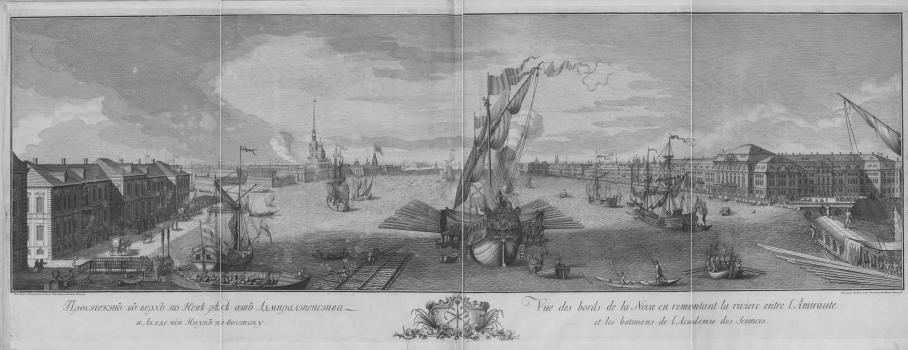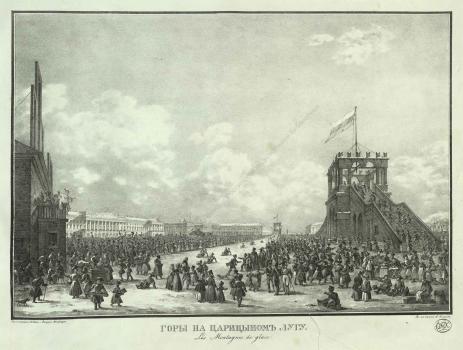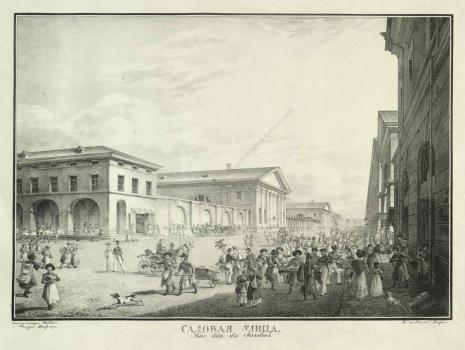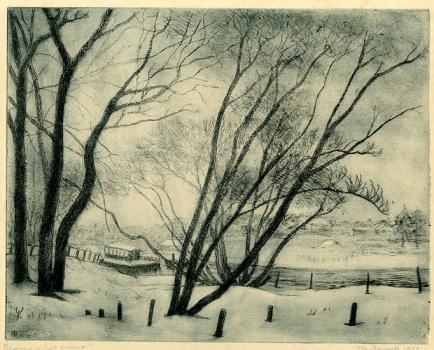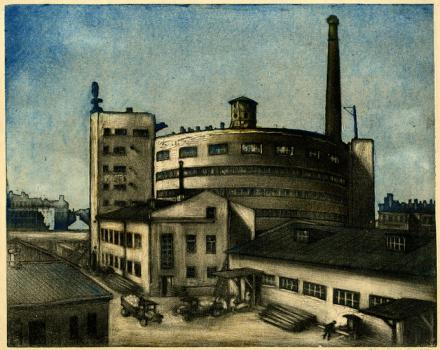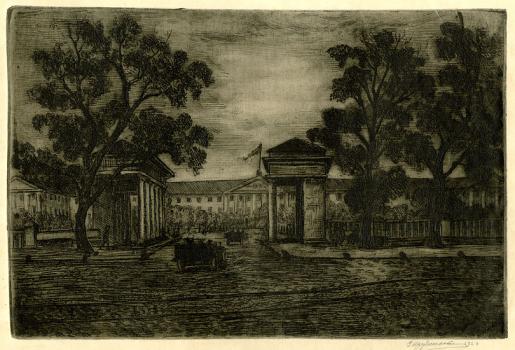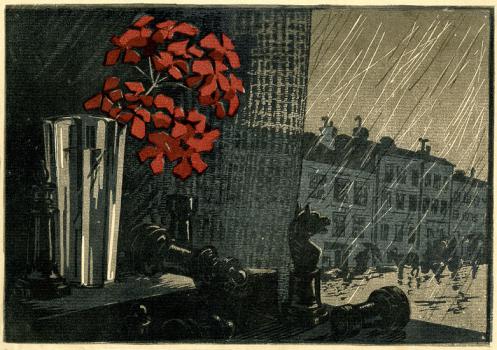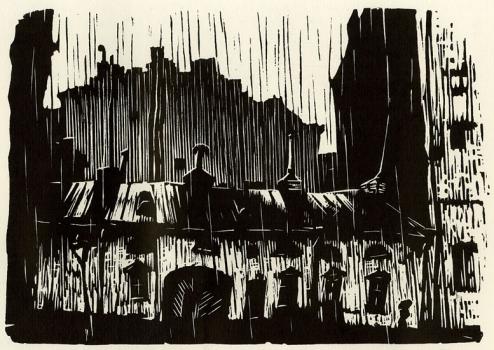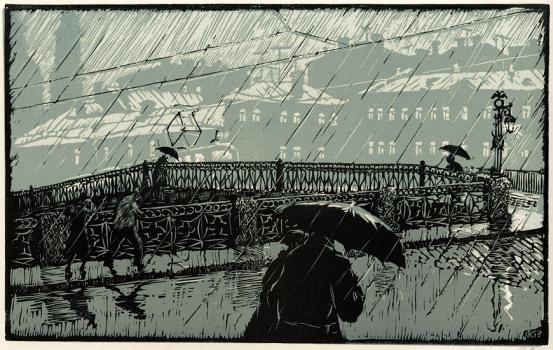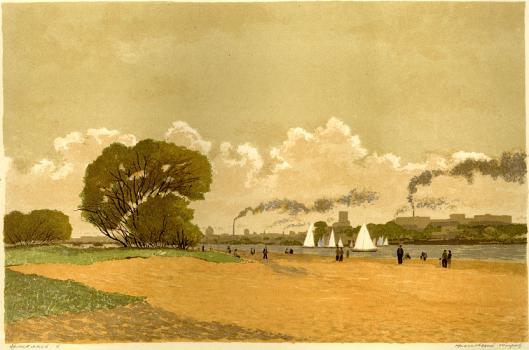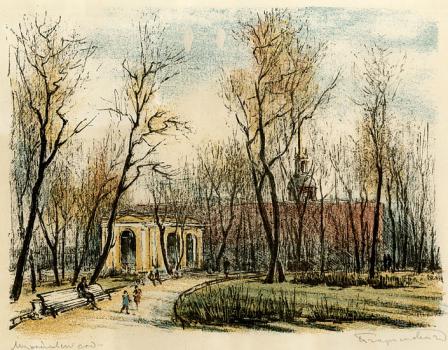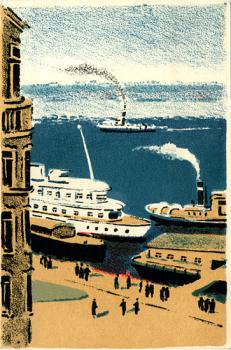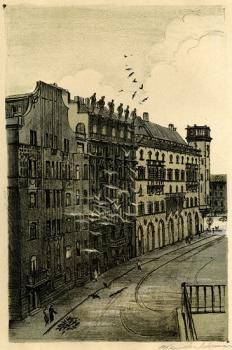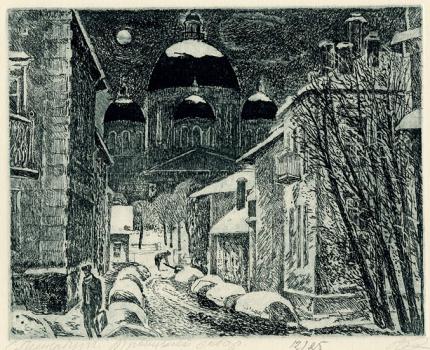Saint Petersburg. Prints of the Past
The 20th Century Graphic Art in the Collections of the National Library of Russia
The genre of urban landscape in the art of the print originated in Russia from the works by such master artists of the eighteenth century as Mikhail Makhaev, Alexei Zubov, Pieter Pickaerdt etc. Their engravings paved the way for search and experiments in the field of view prints which has undergone many changes over time both in techniques and in artistic expression. The Plan of the Capital City of Saint Petersburg, produced by design of Mikhail Makhaev, represents one of early examples of that time. In 1759, the engraving class under
Lithography, a new type of printing was invented in 1797 by the German printmaker and playwright Johann Alois Senefelder. In Russia, it appeared in 1816 and has come into broad use for a long time. As early as in 1820, the Society for the Encouragement of Artists published A Collection of Views of St. Petersburg. The landscape painter Andrei Martynov printed from stone the series Views of St. Petersburg and its Environs (1821), consisting of 65 sheets after his own drawings. The famous Panorama of Nevsky Prospect (1830-1835) was also lithographed by Ivan and Piotr Ivanovs from the sixteen-metre-long watercolor by Vasily Sadovnikov. This work shows in detail all the buildings on either side of the thoroughfare which was eloquently described by Nikolai Gogol: «Almighty Nevsky Prospect! It is the only entertainment of the poor in St. Petersburg festivities!».
The original figure Vasily Mate, who educated a galaxy of talented artists in the Academy of Arts, played an important role in the development of printmaking in Russia during the second half of the nineteenth century. The outstanding expert on the woodcut and etching techniques, one of the organizers of the first exhibitions of graphic art (including those from the private collections of S.S. Botkin, D.A. Rovinsky, E.G. Schwartz), Mate was the forerunner and inspirer for artistic book plates of the twentieth century. He was one of the first to want students to create independent original works of art, rather than reproductions of other artists' work.
Anna Ostroumova-Lebedeva (1871-1955) is considered to be one of his best students. Seeking the release of her creative powers, she studied traditions of French prints and Japanese woodblocks by printmakers of the circle of Ando Hiroshige and Katsushika Hokusai.
The eastern influence is particularly strong in a series of postcards, published by the Community of St. Eugenia in commemoration of the two-hundredth anniversary of St. Petersburg, for example, in the Chain Bridge (1903). A later series (1922), devoted to the views of embankments, bridges and rivers in Saint Petersburg, shows an interesting mixture of landscape with images of ships and barges, often waterlogged and rotting on the background of the noble panorama of the city.
During the late ninteenth - early twentieth centuries, the art of colour printing took its place at the forefront of the printing industry due to lifting the ban on private enterprise.
Many small and medium-sized private printing companies, springing up all over, provided polychrome printing services using a wide range of methods, especially lithography. Thanks to that, works of painting and graphic art became available to almost everyone - the popularity of open letters, often reproducing the masterpieces by famous artists, grew day by day. Successes of the Russian printing industry received recognition at international exhibitions in London and Paris.
Enterprises of I. Kadushin, R. Golike & A. Vilborg, publishing houses such as the Community of St.Eugenia, Richard engaged artists to create all sorts of prints, posters and pieces of applied graphics. Members of the World of Art association, for the most part Mstislav Dobuzhinsky, Yevgeny Lanceray, Georgy Vereisky and others specialized in the genre of view graphics, willingly participated in these activities.
The author of works on engraving techniques Elizabeth Kruglikova (1865-1941) endlessly experimented with mediums of graphic art, discovering all the new potentialities of prints. For example, in the Graphics Room at the Academy of Fine Arts, she tried to engrave on cellulose, worked in a risky and unusual technique of monotype.
Her striving to produce only one impression revealed a desire to make each print unique, like a painting. In the plate Bread-baking Plant in the Barochnaya /Baroque/ street (1937), the vibrant blue sky is united with the effects of light and shade and the striking silhouette of the building into a balanced composition. The etchings Smolny (1923) and Yelagin Island in Winter (1939) are no less expressive. Gentle halftones of snowdrifts were created in them by transparent layers of paint, especially not removed from the block before printing.
Views of St Petrsburg became the themes for works of the master of easel graphics and book illustrations Pavel Shillingovsky (1881 - 1942) only twice, and that is why, these few tens of art woodcuts are particularly valuable. The idea of the suite St. Petersburg. Ruins and Revival(1923), on the one hand, goes back to Jacques Callot's series Miseries of War and, on the other, was inspired by the masterpieces of the Italian engraver Giovanni Battista Piranesi, depicting the ruins of ancient architecture.The irregular rhythm of dense strokes in the plates by Shillingovsky arouses the feeling that the empty city seems to shake under the impact of exploding shells. During the siege of Lenigrad in 1941-1944, the artist turned to the theme of St. Petersburg once again, but managed to produce only a few sheets which undoubtly did their part for the heritage of graphic art of Leningrad from the period of the Second World War.
The pupil of Shillingovsky N.K. Van der Fleet (1901-1998) is one of the unjustly neglected artists. Being a prominent wood engraver, master of lithography, she has created interesting illustrations to the books by such Russian writers and poets Alexander Pushkin, Leo Tolstoy, Alexander Blok and Nikolay Zabolotsky. A rare piece that is very likely a result of her immature experiments, made by using several linoleum blocks, is Still Life with Chess(1926). It is obvious that the author avoids using black, so popular in linocuts, to demonstrate the pictorial possibility of colour prints to represent both a landscape outside the window and an interior of a room.The linocut (or linoleum block printing)is a technique for producing many prints from a single linoleum surface. It flourished in the 1920s, largely because of the advantages of the cheap material (the sheet of linoleum) easy to cut. This relief printing method allowed to enlarge an image, and also simplified the process for multicolour printing. Many famous artists worked in this medium, including Boris Kustodiev, Solomon Yudovin, Oleg Pochtenny, Mikhail Uspensky and others. Andrei Ushin still remained one of the best in this area. His engravings are characterized by laconic forms, an expressive rhythm, intricate lines of spots. Plates of the series Petersburg of Dostoevsky (1989) show the artist's ability to interpret a literary text thoroughly by expressive means of landscape representation.
The experimental lithographic workshop at the Leningrad branch of the Union of Artists of the USSR under the guidance of Georgy Vereysky was established in the 1930s. The graphic artists A.L. Kaplan, A.S. Vedernikov, A.B. Karpova-Lebedinskaya, S.M. Steinberg, and many others worked in it, have significantly contributed to the progress of colour lithography.
The urban landscape genre also found eloquent and many-sided expression in the pieces that were created at the Training Centre of Graphic Art in Leningrad - the best school of applied graphics in the country, established in 1953. Masters of graphic art suggested that their main aim was to maintain the spiritual and aesthetic traditions of the St. Petersburg school which has always been distinguished with its highly professional culture, plastic elegancy, as well as versatile creative understanding of the genre.
